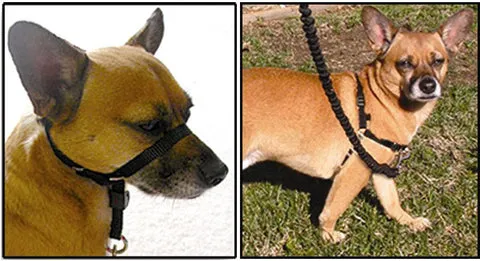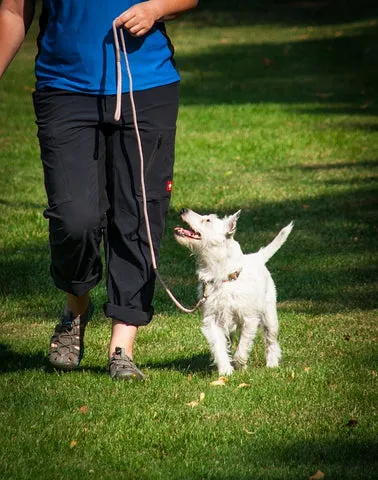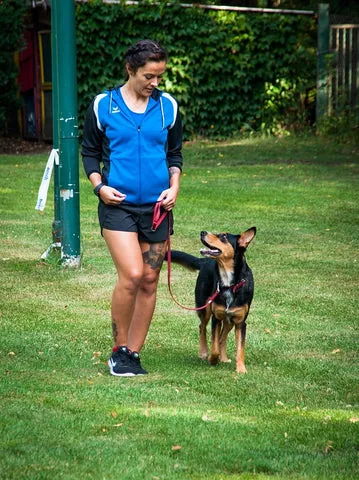Walking your dog should be an enjoyable experience for both of you, but a dog that pulls on the leash can turn a pleasant stroll into a frustrating tug-of-war. Learning how to walk your dog without pulling is one of the most challenging yet rewarding aspects of dog training. With patience and consistent effort, you can transform your walks into harmonious adventures where your dog happily walks by your side, stopping when you stop, turning when you turn, and confidently navigating distractions like other dogs and people. This guide will provide you with step-by-step instructions and practical tips to achieve polite leash manners and strengthen your bond with your canine companion.
Essential Preparations Before Leash Training
While effective leash training teaches your dog to walk politely, certain tools can provide immediate assistance in managing pulling. A head collar or a front-attachment harness can significantly help deter pulling, giving you more control during initial training phases.
A front-attachment harness is a safe and user-friendly no-pull device suitable for most dogs. It works by redirecting your dog’s forward momentum when they pull, gently turning them to the side. For dogs with aggressive tendencies or those requiring maximum control, such as a small owner with a large-breed dog, a head collar for dogs is often the preferred choice. It provides precise control over your dog’s head, which in turn influences the rest of their body.
Both front-attachment harnesses and head collars should only be used with leashes that are a maximum of 6 feet long. Using an excessively long leash with these devices could risk injury to your dog if they reach the end of the leash abruptly while moving at speed.
 A small tan dog wears a head collar on the left and a front-attachment harness on the right*A small tan dog wears a head collar on the left and a front-attachment harness on the right, demonstrating proper fit and style.*
A small tan dog wears a head collar on the left and a front-attachment harness on the right*A small tan dog wears a head collar on the left and a front-attachment harness on the right, demonstrating proper fit and style.*
The “Stop and Reward” Method for Leash Manners
A fundamental and highly effective method for training your dog not to pull on the leash involves a simple stop-and-reward technique. The core principle is to halt your forward movement the instant your dog begins to pull. This teaches your dog that pulling leads to going nowhere. When your dog returns to your side and the leash slackens, immediately reward them with treats and praise. A treat bag worn around your waist can be incredibly convenient for quick rewards during the training process. If your dog isn’t highly motivated by food, consider using a favorite tug toy or a toss of a ball as a reward instead of treats.
Step-by-Step Dog Leash Training
These detailed steps will guide you through the process of teaching your dog to walk politely on a leash.
Step 1: “Walking with My Human Is Delicious!”
Begin leash training by attaching your dog, wearing a standard harness, to a long rope or leash (10-20 feet long, non-retractable) in a familiar outdoor area like your backyard. Have pea-sized pieces of high-value treats, such as fresh meat or cheese, ready.
Decide whether you prefer your dog to walk on your left or right side (left is traditional). Whichever side you choose, deliver the treat reward right by your thigh on that side. This encourages your dog to stay close to that side, associating it with positive reinforcement.
Walk briskly and randomly around your yard. Whenever your dog chooses to walk beside you, reward them with praise and a treat at your preferred side. If they continue walking next to you, reward them for every few steps you take together. As they improve, you can gradually reduce the frequency of rewards. If your dog seems uninterested, bring them inside and try again later when they might be hungrier. Practice until your dog is staying beside you consistently.
Step 2: “It’s Worth My While to Watch Where My Human Is Going and Go Along, Too!”
Start this step by walking in your yard. Wait for a moment when your dog is distracted, sniffing, or lagging behind. Say “let’s go” in an upbeat voice, perhaps slapping your thigh a few times to get their attention, and then turn and walk away from your dog.
When your dog catches up, reward them with praise and a treat at your preferred side. Continue to feed a treat every couple of steps if they maintain their position. If they catch up quickly, offer an extra reward.
If the leash becomes tight and your dog doesn’t move towards you, stop walking and apply gentle leash pressure. This pressure serves as a reminder of your presence and makes ignoring you slightly less pleasant, but it should never be used to forcefully pull your dog. Release the pressure and praise them as soon as they start moving towards you. Once they catch up, reward them with praise and a treat, continuing to reward for every few steps they stay by your side. Practice this step until your dog consistently stays by your side, returning quickly after hearing “let’s go” if they veer off.
A woman feeds a tan dog a treat while on the leash, demonstrating positive reinforcement for good behavior.
Step 3: “I Know When It’s Time to Smell (Or to Pee On) the Roses”
Puppies and dogs need opportunities to sniff and relieve themselves during walks, but you should decide when these “free time” moments occur. While practicing how to walk your dog without pulling, about every 5 minutes (or when you would normally give a food reward), say something like “go sniff” and allow your dog to explore or go potty while on the leash. This is a privilege; if they pull during this free time, say “let’s go” and walk in the opposite direction, signaling the end of the break. When you’re ready to resume walking, simply say “let’s go” and begin moving.
Step 4: “Sometimes I Really Need to Pay Attention to Where My Human Is Going!”
Continue practicing leash training in your yard as in steps one through three, gradually using a shorter leash until you reach a standard 6-foot length. Introduce variations in your walking pace, such as walking extra fast or slow, and incorporate frequent stops and changes in direction. Reward your dog generously if they can maintain their position by your side during these challenges. Gradually reduce the frequency of rewards for normal walking, but continue to provide extra rewards when they successfully navigate distractions or adapt to changes in your walking style.
 White dog on leash watching owner*A white dog on a leash attentively watching its owner, demonstrating focus during training.*
White dog on leash watching owner*A white dog on a leash attentively watching its owner, demonstrating focus during training.*
Taking Leash Training to the Street
When you transition to neighborhood walks, you’ll apply the same techniques learned in the yard, but now with added real-world distractions like friendly strangers, squirrels, and other dogs. Consider using a front-attachment harness or head collar for enhanced control in these more stimulating environments, and always bring high-value treats (like fresh meat or cheese) to keep your dog motivated.
Say “let’s go” and begin walking. If your dog gets distracted or starts to pull, promptly say “let’s go” and change direction. Reward them with treats when they walk politely beside you. Be sure to provide extra treats when it’s especially difficult for them to maintain focus. Don’t forget to offer authorized sniff breaks, as discussed in Step 3, even when leash training a puppy in a more distracting environment.
 Woman walking attentive black and tan dog*A woman walks with an attentive black and tan dog by her side, showcasing a well-behaved dog on a leash.*
Woman walking attentive black and tan dog*A woman walks with an attentive black and tan dog by her side, showcasing a well-behaved dog on a leash.*
Challenging Your Dog During Leash Training
To further solidify your dog’s leash manners, introduce controlled challenges. Outfit your dog in a standard harness attached to a 6-foot leash. Toss a ball or a treat about 20 feet away from you and your leashed dog.
If your dog pulls towards the object, say “let’s go” and turn and walk in the opposite direction. If they walk calmly beside you as you approach the object, allow them to reach it and claim it as their reward. Initially, you might want to use a longer leash or a less desirable object to make this exercise easier for your dog to succeed.
Troubleshooting Common Leash Training Issues
Even with consistent practice, you might encounter some common challenges during leash training:
- Crossing in front of you: If your dog frequently crosses in front of you, stomp or shuffle your feet slightly to make your presence more obvious and encourage them to stay beside you.
- Lagging behind: If your dog lags significantly, they might be frightened or feeling unwell. Use plenty of encouragement rather than pulling them along. If they are lagging to sniff or potty, simply keep walking, applying only gentle pressure on the leash. Remember to use ample rewards when they walk with you.
- Alternating between walking beside you and pulling: If your dog shows this behavior after initial practice, stop rewarding them for coming back to you after pulling. Instead, focus on rewarding them for taking a larger number of consecutive steps by your side, reinforcing sustained good behavior.
 Small white and brown dog on a leash in the snow*A small white and brown dog on a leash, walking calmly in a snowy landscape.*
Small white and brown dog on a leash in the snow*A small white and brown dog on a leash, walking calmly in a snowy landscape.*
How to Train a Dog to Walk On a Leash and Heel
Heeling is a more advanced behavior where your dog walks very closely by your side, highly attentive to you. It’s particularly useful for short periods when you need precise control, such as passing distractions like other animals.
Begin practicing how to train a dog to walk on a leash and heel in a quiet environment like your home. Place a treat in your fist and allow your dog to sniff it. Say “let’s go” (or “heel”) and take a couple of steps, guiding them along with the treat in your fist held near your thigh. Praise and reward them with the treat when they follow your fist with their nose.
Next, practice having your dog follow your empty fist. Continue to praise and reward them for every couple of steps they follow your hand signal. With each session, increase your standards, gradually extending the distance and duration. Your closed fist will serve as a consistent hand signal for “heel.” Once proficient indoors, try practicing outside and in more distracting circumstances.
By consistently applying these techniques, you’ll gain the skills and confidence to teach your dog how to walk your dog without pulling, leading to more enjoyable and stress-free walks for both of you. Explore various dog training aids and puppy supplies to support your training journey.
